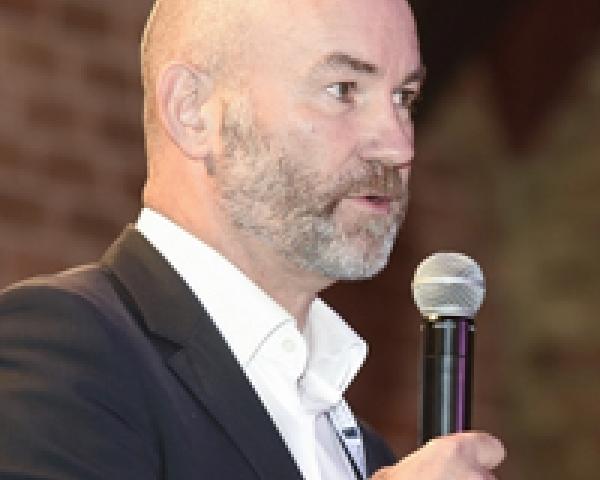The insurance supply chain is typically seen as a linear model. Insurance distribution starts with brokers, ARs and MGAs at the front end. Carriers underwrite risk and decide whether to pay a claim. And the buck stops with the reinsurers. Front to back, risk and premium move from one intermediary to another, each one taking its share. It’s a model that hasn’t really changed over the last century.
“Your fat margin is my opportunity” is the
Jeff Bezos quote that defines the era of digital disruption. We now see tech-savvy entrepreneurs finding ways to “disrupt” established business models using digital and mobile to streamline out-of-date business models oozing with fat margin.
When you look at the world of insurance, it’s easy to imagine that Bezos was looking at the world’s largest industry when he made that quote. It’s no surprise that insurtech has become the new fintech.
The combination of many intermediaries in the supply chain, each one taking margin, together with the inefficient friction that goes with it has fueled the rise in insurtech. When you add in the shift in agency to the consumer (because of the likes of Bezos and how he built Amazon by putting the customer absolutely and unequivocally at the center), it is easy to see why insurance is a juicy target for digital disruptors.
See also: Taking the ‘I’ Out of Insurance Distribution
Redefining the Insurance Supply Chain
As the insurance industry catches up and embraces
the Fourth Industrial Revolution, we will see a redefining of the insurance supply chain. It's started already.
It will evolve from the traditional linear model where risk and premium move front to back in a bi-directional flow. In its place, we see new supply chain models for insurance distribution at the front end with efficient management of risk capital at the back.
Of course, as a highly regulated industry, insurance faces a drag on change from the legislature. But just as regulators and lawmakers made adjustments to accommodate the fintech models for alternative finance, they will follow suit in insurtech. And why wouldn’t they?

In the new model for insurance distribution, the supply chain will co-exist with brands and within ecosystems unconnected to insurance.
Customers will be rated as individuals and not members of a risk pool. A greater share of premiums collected will be set aside to pay claims. Instead of sales commissions, there will be platform fees. Time to pay claims will become the KPI of choice for customers to rate their insurance experience. And as convenience replaces price as the key buying criterion, the way that insurance is distributed will change.
Automation is key for insurance distribution
In the new insurance supply chain, there will be fewer handoffs, less friction, less premium erosion. Just like with Amazon, the customer will be absolutely and unequivocally at the center of the ecosystem.
Trusted brands will own the customer relationship. These brands know the meaning of loyalty and will value these relationships highly. They also understand how expensive it is to build them in the first place, and how easily that can be lost.
Amazon-like levels of service will become the norm for both insurance distribution and paying out claims.
Automation is the key to making it very, very easy to do business.
Of course, someone will need to manage risk capital. This will be the domain of the reinsurers, with the role of the carrier becoming superfluous.
The reinsurers know better than anyone how to manage large pools of risk capital. They’ve been carrying the insurance industry for long enough. In the new insurance supply-chain, firms like
Sherpa will own and manage the customer experience.
The Sherpa model is to charge a value-based annual fee to a customer in return for meeting all insurance needs. This removes sales commission from the equation.
The founder and CEO of Sherpa, Chris Kaye, explained to me,
“Today, insurers pay sales commission for selling the insurance products that the insurers have created.
“We are turning that on its head and creating a membership organization that is unequivocally on the consumer’s side. No more commissions for products you don’t need, instead a flat fee to assure the risks that matter most are protected.”
How does this work in the Sherpa model?
On behalf of customers,
Sherpa goes straight to Gen Re and buys insurance wholesale. Sherpa can distribute personalized insurance products to customers while packaging up parcels of risk at the back end.
This innovative approach is one example of how customer brands will be able to fine tune, personalise and price based on a whole set of new and different risk criteria.
So what? Well today, insurers create the products that they want to sell. Brokers do their best to find the best match of their customer’s needs to the fixed insurance products on offer. But customers end up paying for cover they don’t need. And they don’t always get the specific cover that they do want.
The new approach allows the brand, in this case Sherpa, to personalize the cover specific to the individual while packaging up modules of risk for the expert managers of risk capital.
Go west to see the future of insurance distribution
China’s
ZhongAn epitomizes everything that is insurtech.
It is a 100% digital tech business with around 1,500 employees. More than half of them are developers, and none are in sales. The company also happen to provide insurance, and a lot of it!
In the first three years of trading, ZhongAn wrote more than 5 billion policies. It sold 200 million policies in one day alone last November during China’s annual online shopping fest!
The thing that makes ZhongAn the darling of insurtech is that 99% of all operations are automated. Quote, policy, premium collection and claims are all automated, which is why the company can process 18,000 policies a second.
But it’s ZhongAn’s approach to premium pricing and insurance distribution that really set it apart. First, the insurance business is built around retail ecosystems. The products are embedded in the customer buying process through retail sites. The company makes it super easy to buy insurance, simply by checking a box.
Next, the insurance is micro-priced, based on a personalized premium, unique to the individual customer.
ZhongAn does not use the law of large numbers to price risk premium. Instead, ZhongAn uses big data for dynamic and personalized pricing. There is no single price list for insurance products. Customers are risk-assessed individually and priced accordingly.
For ZhongAn, it is more important to build customer loyalty (aka stickiness) through speed and convenience.
See also: Distribution Debunked (Part 1)
ZhongAn use ecosystems to distribute insurance
A question I get asked a lot is: “Are these insurtechs an insurance firm or a tech firm?” It’s a great question, just like asking if AirBnB is a hotel chain or if Uber is a taxi firm.
Of course, there are many old diehards of the insurance industry who rail against that question and revert back the old mantra of “an insurance company is an insurance company.”

But the reality is that, in this rapidly changing digital world, the fundamental nature of providing a financial safety net is changing, too.
The old “insurance product,” designed by insurance companies to suit their own needs and aimed at customer segments that never claim, is on its way out.
In ZhongAn’s case, it is a tech company first, which is why it can take a fresh approach to insurance, unhampered by old ways of thinking.
When it comes to insurance distribution, ZhongAn’s business model is based on supplying insurance cover through an ecosystem partnership model. The company doesn’t pay broker fees or have to support a huge cost of sale. Instead, it has partnered with leading players that already have a customer base across many different market sectors.
This allows ZhongAn to directly embed insurance products into an online experience, making it really easy for the customer. Customers simply check a box to include the insurance cover. The premium is dynamically, real-time, micro-priced, unique to the customer at that moment. This is all about improving customer experience.
Insurance distribution is going to change, it’s just a matter of time

For many, it is hard to imagine a world where insurance could be any different than how it has been for the past 100 years. To them I say, cast your mind back to 1995.
It was only 20 odd years ago that people were talking about this thing called the World Wide Web and about how everything could change. A lot of it sounded science fiction and the stuff of fantasists at the time. Even so, nobody could have possibly imagined the full extent to which the world would change. And, over such a short span. All because of this thing called the internet.
Just as the supply chains of many industries have changed in the internet era, so will that of the insurance industry. It’s no long a question of “if,” but “when.”
 "Your fat margin is my opportunity"
"Your fat margin is my opportunity"
 In the new model for insurance distribution, the supply chain will co-exist with brands and within ecosystems unconnected to insurance.
Customers will be rated as individuals and not members of a risk pool. A greater share of premiums collected will be set aside to pay claims. Instead of sales commissions, there will be platform fees. Time to pay claims will become the KPI of choice for customers to rate their insurance experience. And as convenience replaces price as the key buying criterion, the way that insurance is distributed will change.
Automation is key for insurance distribution
In the new insurance supply chain, there will be fewer handoffs, less friction, less premium erosion. Just like with Amazon, the customer will be absolutely and unequivocally at the center of the ecosystem.
Trusted brands will own the customer relationship. These brands know the meaning of loyalty and will value these relationships highly. They also understand how expensive it is to build them in the first place, and how easily that can be lost.
Amazon-like levels of service will become the norm for both insurance distribution and paying out claims. Automation is the key to making it very, very easy to do business.
Of course, someone will need to manage risk capital. This will be the domain of the reinsurers, with the role of the carrier becoming superfluous.
The reinsurers know better than anyone how to manage large pools of risk capital. They’ve been carrying the insurance industry for long enough. In the new insurance supply-chain, firms like Sherpa will own and manage the customer experience.
The Sherpa model is to charge a value-based annual fee to a customer in return for meeting all insurance needs. This removes sales commission from the equation.
The founder and CEO of Sherpa, Chris Kaye, explained to me, “Today, insurers pay sales commission for selling the insurance products that the insurers have created.
“We are turning that on its head and creating a membership organization that is unequivocally on the consumer’s side. No more commissions for products you don’t need, instead a flat fee to assure the risks that matter most are protected.”
How does this work in the Sherpa model?
On behalf of customers, Sherpa goes straight to Gen Re and buys insurance wholesale. Sherpa can distribute personalized insurance products to customers while packaging up parcels of risk at the back end.
This innovative approach is one example of how customer brands will be able to fine tune, personalise and price based on a whole set of new and different risk criteria.
So what? Well today, insurers create the products that they want to sell. Brokers do their best to find the best match of their customer’s needs to the fixed insurance products on offer. But customers end up paying for cover they don’t need. And they don’t always get the specific cover that they do want.
The new approach allows the brand, in this case Sherpa, to personalize the cover specific to the individual while packaging up modules of risk for the expert managers of risk capital.
Go west to see the future of insurance distribution
China’s ZhongAn epitomizes everything that is insurtech.
It is a 100% digital tech business with around 1,500 employees. More than half of them are developers, and none are in sales. The company also happen to provide insurance, and a lot of it!
In the first three years of trading, ZhongAn wrote more than 5 billion policies. It sold 200 million policies in one day alone last November during China’s annual online shopping fest!
The thing that makes ZhongAn the darling of insurtech is that 99% of all operations are automated. Quote, policy, premium collection and claims are all automated, which is why the company can process 18,000 policies a second.
But it’s ZhongAn’s approach to premium pricing and insurance distribution that really set it apart. First, the insurance business is built around retail ecosystems. The products are embedded in the customer buying process through retail sites. The company makes it super easy to buy insurance, simply by checking a box.
Next, the insurance is micro-priced, based on a personalized premium, unique to the individual customer.
ZhongAn does not use the law of large numbers to price risk premium. Instead, ZhongAn uses big data for dynamic and personalized pricing. There is no single price list for insurance products. Customers are risk-assessed individually and priced accordingly.
For ZhongAn, it is more important to build customer loyalty (aka stickiness) through speed and convenience.
See also: Distribution Debunked (Part 1)
ZhongAn use ecosystems to distribute insurance
A question I get asked a lot is: “Are these insurtechs an insurance firm or a tech firm?” It’s a great question, just like asking if AirBnB is a hotel chain or if Uber is a taxi firm.
Of course, there are many old diehards of the insurance industry who rail against that question and revert back the old mantra of “an insurance company is an insurance company.”
In the new model for insurance distribution, the supply chain will co-exist with brands and within ecosystems unconnected to insurance.
Customers will be rated as individuals and not members of a risk pool. A greater share of premiums collected will be set aside to pay claims. Instead of sales commissions, there will be platform fees. Time to pay claims will become the KPI of choice for customers to rate their insurance experience. And as convenience replaces price as the key buying criterion, the way that insurance is distributed will change.
Automation is key for insurance distribution
In the new insurance supply chain, there will be fewer handoffs, less friction, less premium erosion. Just like with Amazon, the customer will be absolutely and unequivocally at the center of the ecosystem.
Trusted brands will own the customer relationship. These brands know the meaning of loyalty and will value these relationships highly. They also understand how expensive it is to build them in the first place, and how easily that can be lost.
Amazon-like levels of service will become the norm for both insurance distribution and paying out claims. Automation is the key to making it very, very easy to do business.
Of course, someone will need to manage risk capital. This will be the domain of the reinsurers, with the role of the carrier becoming superfluous.
The reinsurers know better than anyone how to manage large pools of risk capital. They’ve been carrying the insurance industry for long enough. In the new insurance supply-chain, firms like Sherpa will own and manage the customer experience.
The Sherpa model is to charge a value-based annual fee to a customer in return for meeting all insurance needs. This removes sales commission from the equation.
The founder and CEO of Sherpa, Chris Kaye, explained to me, “Today, insurers pay sales commission for selling the insurance products that the insurers have created.
“We are turning that on its head and creating a membership organization that is unequivocally on the consumer’s side. No more commissions for products you don’t need, instead a flat fee to assure the risks that matter most are protected.”
How does this work in the Sherpa model?
On behalf of customers, Sherpa goes straight to Gen Re and buys insurance wholesale. Sherpa can distribute personalized insurance products to customers while packaging up parcels of risk at the back end.
This innovative approach is one example of how customer brands will be able to fine tune, personalise and price based on a whole set of new and different risk criteria.
So what? Well today, insurers create the products that they want to sell. Brokers do their best to find the best match of their customer’s needs to the fixed insurance products on offer. But customers end up paying for cover they don’t need. And they don’t always get the specific cover that they do want.
The new approach allows the brand, in this case Sherpa, to personalize the cover specific to the individual while packaging up modules of risk for the expert managers of risk capital.
Go west to see the future of insurance distribution
China’s ZhongAn epitomizes everything that is insurtech.
It is a 100% digital tech business with around 1,500 employees. More than half of them are developers, and none are in sales. The company also happen to provide insurance, and a lot of it!
In the first three years of trading, ZhongAn wrote more than 5 billion policies. It sold 200 million policies in one day alone last November during China’s annual online shopping fest!
The thing that makes ZhongAn the darling of insurtech is that 99% of all operations are automated. Quote, policy, premium collection and claims are all automated, which is why the company can process 18,000 policies a second.
But it’s ZhongAn’s approach to premium pricing and insurance distribution that really set it apart. First, the insurance business is built around retail ecosystems. The products are embedded in the customer buying process through retail sites. The company makes it super easy to buy insurance, simply by checking a box.
Next, the insurance is micro-priced, based on a personalized premium, unique to the individual customer.
ZhongAn does not use the law of large numbers to price risk premium. Instead, ZhongAn uses big data for dynamic and personalized pricing. There is no single price list for insurance products. Customers are risk-assessed individually and priced accordingly.
For ZhongAn, it is more important to build customer loyalty (aka stickiness) through speed and convenience.
See also: Distribution Debunked (Part 1)
ZhongAn use ecosystems to distribute insurance
A question I get asked a lot is: “Are these insurtechs an insurance firm or a tech firm?” It’s a great question, just like asking if AirBnB is a hotel chain or if Uber is a taxi firm.
Of course, there are many old diehards of the insurance industry who rail against that question and revert back the old mantra of “an insurance company is an insurance company.”
 But the reality is that, in this rapidly changing digital world, the fundamental nature of providing a financial safety net is changing, too.
The old “insurance product,” designed by insurance companies to suit their own needs and aimed at customer segments that never claim, is on its way out.
In ZhongAn’s case, it is a tech company first, which is why it can take a fresh approach to insurance, unhampered by old ways of thinking.
When it comes to insurance distribution, ZhongAn’s business model is based on supplying insurance cover through an ecosystem partnership model. The company doesn’t pay broker fees or have to support a huge cost of sale. Instead, it has partnered with leading players that already have a customer base across many different market sectors.
This allows ZhongAn to directly embed insurance products into an online experience, making it really easy for the customer. Customers simply check a box to include the insurance cover. The premium is dynamically, real-time, micro-priced, unique to the customer at that moment. This is all about improving customer experience.
Insurance distribution is going to change, it’s just a matter of time
But the reality is that, in this rapidly changing digital world, the fundamental nature of providing a financial safety net is changing, too.
The old “insurance product,” designed by insurance companies to suit their own needs and aimed at customer segments that never claim, is on its way out.
In ZhongAn’s case, it is a tech company first, which is why it can take a fresh approach to insurance, unhampered by old ways of thinking.
When it comes to insurance distribution, ZhongAn’s business model is based on supplying insurance cover through an ecosystem partnership model. The company doesn’t pay broker fees or have to support a huge cost of sale. Instead, it has partnered with leading players that already have a customer base across many different market sectors.
This allows ZhongAn to directly embed insurance products into an online experience, making it really easy for the customer. Customers simply check a box to include the insurance cover. The premium is dynamically, real-time, micro-priced, unique to the customer at that moment. This is all about improving customer experience.
Insurance distribution is going to change, it’s just a matter of time
 For many, it is hard to imagine a world where insurance could be any different than how it has been for the past 100 years. To them I say, cast your mind back to 1995.
It was only 20 odd years ago that people were talking about this thing called the World Wide Web and about how everything could change. A lot of it sounded science fiction and the stuff of fantasists at the time. Even so, nobody could have possibly imagined the full extent to which the world would change. And, over such a short span. All because of this thing called the internet.
Just as the supply chains of many industries have changed in the internet era, so will that of the insurance industry. It’s no long a question of “if,” but “when.”
For many, it is hard to imagine a world where insurance could be any different than how it has been for the past 100 years. To them I say, cast your mind back to 1995.
It was only 20 odd years ago that people were talking about this thing called the World Wide Web and about how everything could change. A lot of it sounded science fiction and the stuff of fantasists at the time. Even so, nobody could have possibly imagined the full extent to which the world would change. And, over such a short span. All because of this thing called the internet.
Just as the supply chains of many industries have changed in the internet era, so will that of the insurance industry. It’s no long a question of “if,” but “when.”








